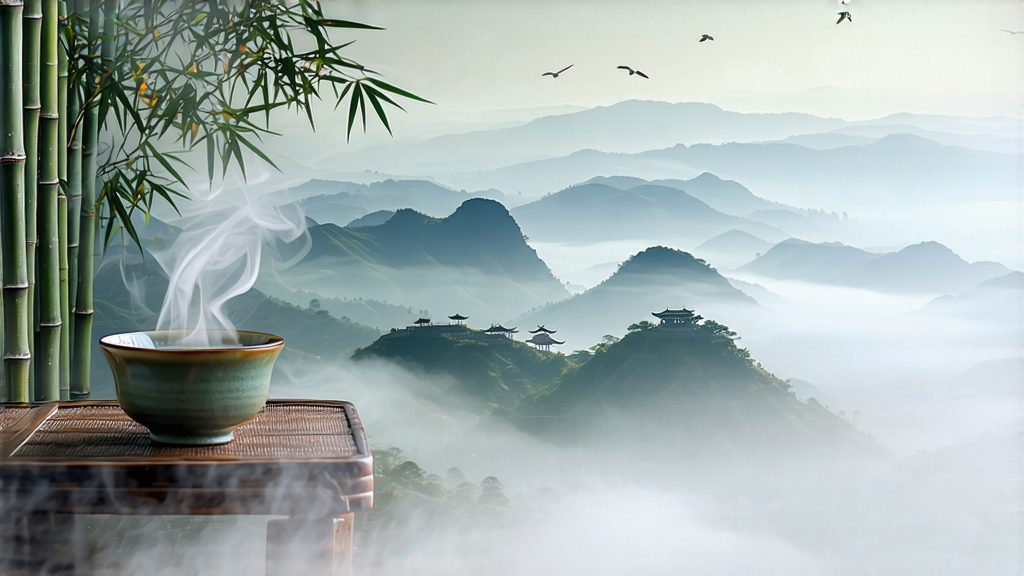
If green tea is the fresh-faced youth of Chinese tea and pu-erh the wise elder, then yellow tea is the discreet scholar who slips away before the party ends. Among the small yellow-tea family, Meng Ding Huang Ya—“the yellow bud from Meng Ding peak”—carries the most layered story, a tale that begins 1,200 years ago when poets still rode donkeys up the Min River and tea was pressed into cakes for the Tang emperor’s cavalry.
History: From Daoist Altar to Imperial Cup
Meng Ding mountain rises 1,450 m above the Sichuan basin, its ridge permanently wrapped in a slow-moving cloud that local farmers call “the silk curtain.” The first record of tea here appears in a Daoist altar inscription dated 742 CE: “Offer the bud of the immortal tree, steam it thrice, wrap it in silk, let it rest in the cave of the yellow dragon.” By the Song dynasty the buds were so coveted that court officials sealed the mountain each spring; anyone caught smuggling seedlings faced tattooed exile. When the Ming emperor abolished compressed tea in 1391, Meng Ding switched to loose leaf, but the secret “men huang” (sealed yellowing) step survived inside monastery walls. For three centuries the tea vanished from written records, re-emerging only in 1959 when a Sichuan trade delegation found an 85-year-old monk who still knew the full choreography. Today less than 3,000 kg leave the mountain each year, most allocated to state banquets; what reaches the open market is often gone within weeks.
Micro-Terroir: Where Clouds Touch Volcanic Soil
The garden sits on a Pleistocene lava dome, so the loam is flecked with glossy obsidian that retains the day’s heat and radiates it back at night. Average humidity hovers at 88 %, ideal for the slow enzymatic oxidation that defines yellow tea. Only three cultivars are permitted: the ancient “Gan Dan” (sweet liver), its albino sport “Bai Hua,” and a newly selected clone “Chuan Huang 2” that keeps the same amino-acid profile but resists leaf-hopper. Picking begins when 75 % of the buds still wear their winter down, usually the last week of March, before Qingming. One kilogram of finished tea demands 42,000 buds, all plucked between 6:30 and 9:00 a.m. while the mountain fog is still cold; if the sun burns the mist away, the pickers descend and wait for tomorrow.
Craft: The Six Acts of Disappearing Green
- Sha Qing (kill-green) – 160 °C for 90 seconds in a bronze wok shaped like an inverted bell. The goal is not full deactivation but to cripple the polyphenol oxidase so the leaf can still whisper later.
- Re Xiang (hot wrapping) – the leaves are scooped into a linen pouch and buried for 40 minutes in charcoal ash at 55 °C. This “first sweat” turns the bud tip the color of ivory piano keys.
- San Shi (three spreads) – the pouch is opened, leaves are fanned on a bamboo tray for 20 minutes, then rewrapped; the cycle repeats three times over six hours, lowering moisture from 55 % to 35 %.
- Men Huang (sealed yellowing) – the semi-dry leaf is piled 8 cm deep inside a cedar box lined with wet kraft paper. The box is slid into a cave where temperature is a constant 24 °C and RH 82 %. For 48 hours the leaf breathes its own carbon dioxide, a gentle fermentation that converts catechins into theaflavins and releases a note of steamed pumpkin. Masters listen for a faint whistling sound—called “the yellow song”—that tells them the pile is alive.
- Zu Xing (foot-shaping) – while still warm, the leaf is rolled under bare feet covered with cotton socks; pressure is calibrated to the roller’s pulse, never exceeding 2 kg/cm². The buds curve into tiny fishhooks, locking the aroma inside ruptured cells.
- Bei Gan (back-drying) – low charcoal heat at 45 °C for three hours, then a final 70 °C burst for five minutes to fix the golden tint.